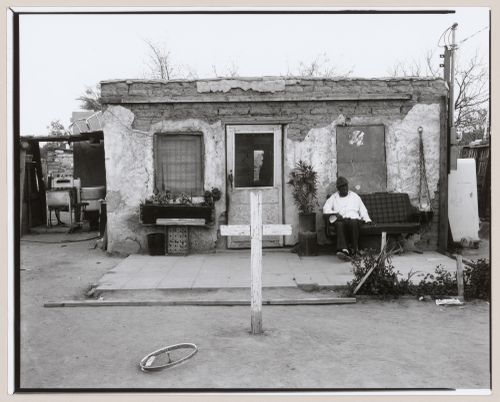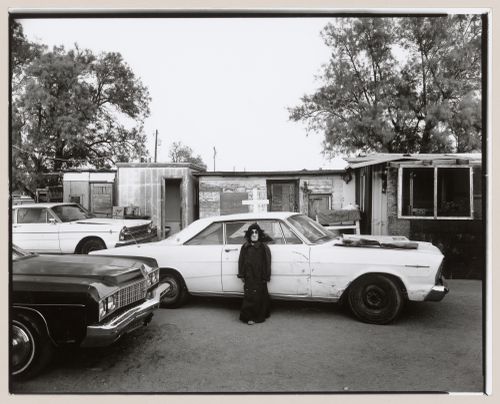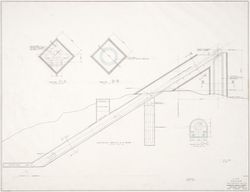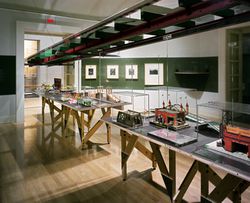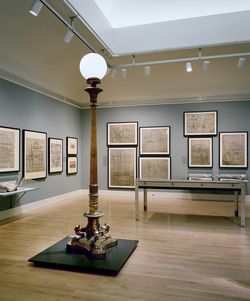PH1989:0155
Description:
One of a series of forty-four photographs of the Yaqui community of Old Pascua by Lorne Greenberg. The photographs document the relationship of household and church in the Yaqui community. The photographs were exhibited at the Arizona State Museum in 1983. The CCA collection includes ten photographs from the series (PH1989:0147 - PH1989:0156). In 1978, the San Ignacio Yaqui Council applied for Community Development Block Grants (CDBG), which had been established by the United States Government in 1974. The community first received CDBG funding in 1979/1980. Since that time, most of the owner-occupied houses in Pascua Village have been torn down and new homes have been built.
architecture
1981
View of cross in yard in front of a house with a man sitting outside, Old Pascua, Tucson, Arizona, United States (from a series documenting the Yaqui community of Old Pascua)
Actions:
PH1989:0155
Description:
One of a series of forty-four photographs of the Yaqui community of Old Pascua by Lorne Greenberg. The photographs document the relationship of household and church in the Yaqui community. The photographs were exhibited at the Arizona State Museum in 1983. The CCA collection includes ten photographs from the series (PH1989:0147 - PH1989:0156). In 1978, the San Ignacio Yaqui Council applied for Community Development Block Grants (CDBG), which had been established by the United States Government in 1974. The community first received CDBG funding in 1979/1980. Since that time, most of the owner-occupied houses in Pascua Village have been torn down and new homes have been built.
architecture
PH1989:0156
Description:
One of a series of forty-four photographs of the Yaqui community of Old Pascua by Lorne Greenberg. The photographs document the relationship of household and church in the Yaqui community. The photographs were exhibited at the Arizona State Museum in 1983. The CCA collection includes ten photographs from the series (PH1989:0147 - PH1989:0156). In 1978, the San Ignacio Yaqui Council applied for Community Development Block Grants (CDBG), which had been established by the United States Government in 1974. The community first received CDBG funding in 1979/1980. Since that time, most of the owner-occupied houses in Pascua Village have been torn down and new homes have been built.
architecture
1981
View of child wearing Halloween costume in front of car in yard with cross, Old Pascua, Tucson, Arizona, United States (from a series documenting the Yaqui community of Old Pascua)
Actions:
PH1989:0156
Description:
One of a series of forty-four photographs of the Yaqui community of Old Pascua by Lorne Greenberg. The photographs document the relationship of household and church in the Yaqui community. The photographs were exhibited at the Arizona State Museum in 1983. The CCA collection includes ten photographs from the series (PH1989:0147 - PH1989:0156). In 1978, the San Ignacio Yaqui Council applied for Community Development Block Grants (CDBG), which had been established by the United States Government in 1974. The community first received CDBG funding in 1979/1980. Since that time, most of the owner-occupied houses in Pascua Village have been torn down and new homes have been built.
architecture
Series
CD041.S3
Description:
This series documents two projects by the firm Eva Vecsei Architect. In 1973, Vecsei opened her own private practice after her departure from the Dimitri Dimakopoulos’ firm, where she worked from 1971 to 1973. In 1973, Vecsei was hired as an architect by Group Concordia Developers (GCD) to design La Cité, a high density mixed-use residential and commercial project in Milton Park, Montréal. The project was comprised of multifunctional complexes of residential units, offices, a shopping mall, and a hotel with a year-round outdoor pool. The project was realized by the architects Eva H. Vecsei and Dobush Stewart Longpré Marchand Goudreau. The project is also known as "Cité Concordia". The Place Bonaventure was also developed by GCD, where Vecsei was the head project designer from 1964 to 1967. Besides these projects Eva Vecsei Architect also designed concepts for the city centre (1976) and a mixed-use complex (1978) in Karachi, Pakistan. The bulk of the Eva Hollo Vecsei collection is arranged in this series and was produced between 1969 and 2008. Records are predominantly from 1974-1976, which correspond to the period of the La Cité project. Documenting La Cité are architectural records, such as presentation, design, and working drawings, as well as photographs, publications, slides, clippings, digital material (photographs), and a presentation document. This series also includes two clippings on the mixed-use complex in Karachi.
1969-2008
Eva Vecsei Architect (1973-1980)
Actions:
CD041.S3
Description:
This series documents two projects by the firm Eva Vecsei Architect. In 1973, Vecsei opened her own private practice after her departure from the Dimitri Dimakopoulos’ firm, where she worked from 1971 to 1973. In 1973, Vecsei was hired as an architect by Group Concordia Developers (GCD) to design La Cité, a high density mixed-use residential and commercial project in Milton Park, Montréal. The project was comprised of multifunctional complexes of residential units, offices, a shopping mall, and a hotel with a year-round outdoor pool. The project was realized by the architects Eva H. Vecsei and Dobush Stewart Longpré Marchand Goudreau. The project is also known as "Cité Concordia". The Place Bonaventure was also developed by GCD, where Vecsei was the head project designer from 1964 to 1967. Besides these projects Eva Vecsei Architect also designed concepts for the city centre (1976) and a mixed-use complex (1978) in Karachi, Pakistan. The bulk of the Eva Hollo Vecsei collection is arranged in this series and was produced between 1969 and 2008. Records are predominantly from 1974-1976, which correspond to the period of the La Cité project. Documenting La Cité are architectural records, such as presentation, design, and working drawings, as well as photographs, publications, slides, clippings, digital material (photographs), and a presentation document. This series also includes two clippings on the mixed-use complex in Karachi.
Series
1969-2008
archives
Level of archival description:
Fonds
Aditya Prakash fonds
AP206
Synopsis:
The Aditya Prakash fonds documents the professional practice of modernist Indian architect Aditya Prakash from his studies in London in 1947 to his death in 2008. His seminal work as a junior architect on the Chandigarh Capitol Project in the 1950s is recorded along with documentation from his solo career after 1960, including approximately 82 architectural projects. His professional work as an artist, photographer, writer, academic and theatre enthusiast are also well documented through drawings, photographic materials and textual records.
1947-2008
Aditya Prakash fonds
Actions:
AP206
Synopsis:
The Aditya Prakash fonds documents the professional practice of modernist Indian architect Aditya Prakash from his studies in London in 1947 to his death in 2008. His seminal work as a junior architect on the Chandigarh Capitol Project in the 1950s is recorded along with documentation from his solo career after 1960, including approximately 82 architectural projects. His professional work as an artist, photographer, writer, academic and theatre enthusiast are also well documented through drawings, photographic materials and textual records.
archives
Level of archival description:
Fonds
1947-2008
Project
AP207.S1.1971.PR04
Description:
This project series documents Pettena's performance "Vestirsi Di Siede", also know in English as "Wearable Chairs". The performance was carried out between 3 pm and 5 pm on February 12, 1971, in the streets of Minneapolis by ten students of Pettena at the Minneapolis College of Art and Design. The students, each wearing a portable chair harnessed on their back, wandered around the city, either by foot or by bus, and than returned to the college. "In this performance, it was the body that activated and gave meaning to the object: the chair only taking on meaning when carried, otherwise, it became disjointed." [1] The chairs were then put on display at the Minneapolis Institute of Art. A second edition of the performance was also carried out with the students from Nuova Accademia di Belle Arti (NABA) in Milan, 2011, and an installation of the chairs was presented at the exhibition "Un art pauvre" at the Centre Pompidou in 2016. The project series contains photographs of the performance by the students of the Minneapolis College of Art and Design and photographs of the exhibit at the Minneapolis Institute of Art in 1971. It also contains three sketches for the chairs, a drawing of the performance and a statement about the perfomance. The project series also includes photographs of the performance of the NABA students in 2011. Source: [1] FRAC Centre-Val de Loire, http://www.frac-centre.fr/_en/art-and-architecture-collection/pettena-gianni/wearable-chairs-verstirsi-siede-317.html?authID=148&ensembleID=1286 (last accessed 11 November 2019)
1971-2017
Vestirsi Di Siede [Wearable Chairs] (1971)
Actions:
AP207.S1.1971.PR04
Description:
This project series documents Pettena's performance "Vestirsi Di Siede", also know in English as "Wearable Chairs". The performance was carried out between 3 pm and 5 pm on February 12, 1971, in the streets of Minneapolis by ten students of Pettena at the Minneapolis College of Art and Design. The students, each wearing a portable chair harnessed on their back, wandered around the city, either by foot or by bus, and than returned to the college. "In this performance, it was the body that activated and gave meaning to the object: the chair only taking on meaning when carried, otherwise, it became disjointed." [1] The chairs were then put on display at the Minneapolis Institute of Art. A second edition of the performance was also carried out with the students from Nuova Accademia di Belle Arti (NABA) in Milan, 2011, and an installation of the chairs was presented at the exhibition "Un art pauvre" at the Centre Pompidou in 2016. The project series contains photographs of the performance by the students of the Minneapolis College of Art and Design and photographs of the exhibit at the Minneapolis Institute of Art in 1971. It also contains three sketches for the chairs, a drawing of the performance and a statement about the perfomance. The project series also includes photographs of the performance of the NABA students in 2011. Source: [1] FRAC Centre-Val de Loire, http://www.frac-centre.fr/_en/art-and-architecture-collection/pettena-gianni/wearable-chairs-verstirsi-siede-317.html?authID=148&ensembleID=1286 (last accessed 11 November 2019)
Project
1971-2017
Myron Goldsmith’s architectural works show how an economy of means and a modest approach can generate a profoundly poetic expression. Myron Goldsmith: Poet of Structure reveals how the architect’s methods and ideas are formed, developed, and disseminated by drawing upon the body of notes, sketchbooks, and study documents found in the collection of Goldsmith’s personal(...)
Main galleries
13 March 1991 to 2 June 1991
Myron Goldsmith: Poet of Structure
Actions:
Description:
Myron Goldsmith’s architectural works show how an economy of means and a modest approach can generate a profoundly poetic expression. Myron Goldsmith: Poet of Structure reveals how the architect’s methods and ideas are formed, developed, and disseminated by drawing upon the body of notes, sketchbooks, and study documents found in the collection of Goldsmith’s personal(...)
Main galleries
archives
Level of archival description:
Fonds
Kenneth Frampton fonds
AP197
Synopsis:
The Kenneth Frampton fonds, 1958-2016, documents the professional career of Kenneth Frampton – British architect, historian, theorist, and Ware professor of Architecture at the Graduate School of Architecture, Planning and Preservation (GSAPP) at Columbia University. Materials in the fonds consist of approximately 28.37 l.m. of textual records, 3966 photographs and prints, 3168 postcards, 2733 slides, 824 drawings (including reprographic copies), 470 negatives, 151 35 mm negatives, 105 posters, 30 objects, 23 audio cassettes, 18 VHS tapes, 15 transparencies, 3 tape reels, 2 microfilms, and 2 vinyl records.
1958-2016
Kenneth Frampton fonds
Actions:
AP197
Synopsis:
The Kenneth Frampton fonds, 1958-2016, documents the professional career of Kenneth Frampton – British architect, historian, theorist, and Ware professor of Architecture at the Graduate School of Architecture, Planning and Preservation (GSAPP) at Columbia University. Materials in the fonds consist of approximately 28.37 l.m. of textual records, 3966 photographs and prints, 3168 postcards, 2733 slides, 824 drawings (including reprographic copies), 470 negatives, 151 35 mm negatives, 105 posters, 30 objects, 23 audio cassettes, 18 VHS tapes, 15 transparencies, 3 tape reels, 2 microfilms, and 2 vinyl records.
archives
Level of archival description:
Fonds
1958-2016
Toys and Transport
Every new transportation link and every change in systems of urban mobility introduces new infrastructure to the urban landscape: massive cuts enabling railway tracks to converge at a terminal or junction; wide railyards that service suburban and metropolitan transit systems; the proliferation of bridges, ramps, elevated highways, freeway cuts, parking lots, and even(...)
Octagonal gallery
15 November 2000 to 1 April 2001
Toys and Transport
Actions:
Description:
Every new transportation link and every change in systems of urban mobility introduces new infrastructure to the urban landscape: massive cuts enabling railway tracks to converge at a terminal or junction; wide railyards that service suburban and metropolitan transit systems; the proliferation of bridges, ramps, elevated highways, freeway cuts, parking lots, and even(...)
Octagonal gallery
This exhibition looks at the transformation of Montréal from a nineteenth century merchant city to the metropolis of Canada. It examines the elements that made Montréal a political, social, and economic centre and explores the unique character of its architecture. The exhibition brings together some 350 objects, including drawings from the CCA collection by Montréal(...)
Main galleries
18 March 1998 to 24 May 1998
Montréal Métropole, 1880–1930
Actions:
Description:
This exhibition looks at the transformation of Montréal from a nineteenth century merchant city to the metropolis of Canada. It examines the elements that made Montréal a political, social, and economic centre and explores the unique character of its architecture. The exhibition brings together some 350 objects, including drawings from the CCA collection by Montréal(...)
Main galleries
archives
Level of archival description:
Fonds
Brian Boigon fonds
AP188
Synopsis:
The Brian Boigon fonds, 1981–2015, documents various creative and professional projects by artist and data-architect, Brian Boigon. The majority of the fonds documents the multidisciplinary symposium series Culture Lab. Material in the fonds also documents Boigon’s research into cartoon movement in cyberspace in the form of both the Cartoon Regulators and Spillville. The fonds also contains records pertaining to Boigon’s web design company, Roller Coaster Studios. The records in the fonds largely consist of research and planning material, photographs and AV recordings documenting the projects, and sketches by Boigon and others.
1981 - 2015
Brian Boigon fonds
Actions:
AP188
Synopsis:
The Brian Boigon fonds, 1981–2015, documents various creative and professional projects by artist and data-architect, Brian Boigon. The majority of the fonds documents the multidisciplinary symposium series Culture Lab. Material in the fonds also documents Boigon’s research into cartoon movement in cyberspace in the form of both the Cartoon Regulators and Spillville. The fonds also contains records pertaining to Boigon’s web design company, Roller Coaster Studios. The records in the fonds largely consist of research and planning material, photographs and AV recordings documenting the projects, and sketches by Boigon and others.
archives
Level of archival description:
Fonds
1981 - 2015
